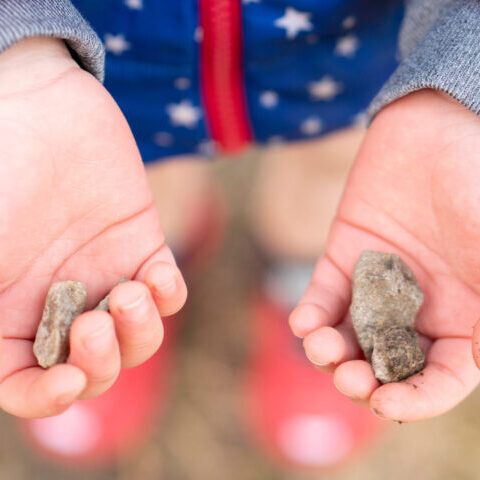Materials such as rocks can be important additions to a preschool’s outdoor play area. Such open-ended items are sometimes called “loose parts.” When children play with loose parts, they can gain fine- and gross-motor skills. They can also apply some of the principles of art, science, and engineering.
Invite children to study rocks as they play.
- Set up a special space with stones of different shapes, sizes, and weights. You might ask families or businesses (garden centers, building supply stores, or contractors) to donate some rocks to your program.
- Encourage safety and respect for others’ work by inviting children to help make rules for using rocks on the playground. Important considerations might include lifting heavy rocks carefully or asking an adult for help, never throwing rocks, making sure not to roll heavy rocks over another person’s hands or feet, and asking before using a rock from someone else’s workspace.
- Ask questions that invite children to investigate: “Do you think any of the rocks will float on water?” “Which do you think is heavier—this bucket of rocks or that bucket of sand?” “Do you think that wet rocks will stick together like wet sand does?”
- Suggest that families send “work clothes” for children to wear when they play with rocks. Some children may prefer wearing yard gloves while handling rocks.
Encourage children to build with the rocks.
- Show the class photographs of Illinois rock formations such as those at Garden of the Gods. Share nonfiction books, builders’ magazines, websites, and videos about ways people have used rocks to build or to make art.
- Invite children to plan their own rock formations, structures, and artistic designs. What do they want to make or build? Which rocks will they use? Do they want to add some other materials such as sand, sticks, leaves, or snow?
- Let children try to make their designs or structures on different surfaces—sand, mulch, and boards. Challenge them to build on ramps or uneven surfaces.
- Offer sturdy buckets, trowels, shovels, and wheel toys for moving the rocks. You might also include a heavy-duty spring scale or balance scale. Add lengths of plastic gutter that children can use as “slides” for rocks or gravel.
Talk about what the children do with rocks.
- Invite children to report on their rock play during class meetings. Some children may have an easier time explaining their experience if they can point to a photo of their work while describing their actions.
- Introduce words such as symmetry, balance, stack, base, collapse, and support to help children describe what they have done and what they have made.
- Ask children to sketch and photograph what they have done with rocks. Make a book or bulletin board display of the photos and drawings. Include some of their comments about what they did.
IEL Resources
- Resource List: Science Exploration for Preschoolers


 PDF
PDF